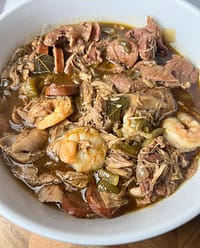Gumbo: A Taste of Louisiana’s Soul in Your Kitchen
Introduction
Gumbo, the official state cuisine of Louisiana, is a hearty stew that embodies the rich cultural tapestry of the American South. With roots in African, French, and Native American culinary traditions, gumbo is more than just a dish—it’s a celebration of history, community, and flavor. Today, we’re diving deep into a classic gumbo recipe that will transport your taste buds straight to the bayou.
Recipe Overview
Our gumbo recipe combines chicken, shrimp, and sausage in a rich, flavorful broth thickened with a dark roux. Key ingredients include okra, bell pepper, and a blend of Cajun spices. The recipe’s cornerstone technique is the creation of a perfect roux, which forms the foundation of this iconic dish.
Breaking Down the Gumbo
1. Preparing the Chicken
Process: We start by seasoning and boiling chicken legs. This step is crucial for infusing flavor into the meat and reducing overall cooking time.
Tip: Don’t discard the cooking liquid! It can be used to enhance your chicken stock for extra flavor.
Variation: While chicken legs are traditional, you could use boneless thighs for easier eating.
Personal Note: I once tried using chicken breast, but found it became too dry. Stick with dark meat for the best results!
2. Creating the Roux
Process: The roux is made by cooking flour in oil until it reaches a dark brown color. This process requires patience and constant stirring.
Tip: Use a heavy-bottomed pot to prevent burning, and don’t rush this step—a good roux can take up to 45 minutes to develop.
Variation: For a healthier option, you can oven-roast your flour to achieve a similar color without oil.
Personal Experience: My first attempt at roux was a disaster—I walked away for a minute and came back to a burnt mess. Stay vigilant!
3. The Trinity and Seasonings
Process: Sautéing bell pepper and onion in the roux forms the base of our gumbo’s flavor. We’re using celery salt instead of fresh celery for convenience.
Tip: Add your spices at this stage to bloom their flavors in the oil.
Variation: Feel free to adjust the spice levels to your taste. Cayenne pepper can add extra heat if desired.
Anecdote: My grandmother always said, “The trinity is sacred in gumbo—don’t skimp on it!”
4. Building the Gumbo
Process: We add stock to the roux and vegetables, then incorporate pre-cooked chicken, sausage, and okra.
Tip: Simmer gently to allow flavors to meld without overcooking the vegetables.
Variation: Try using duck or andouille sausage for a different flavor profile.
Personal Note: I love adding file powder at the end for an authentic touch and extra thickening power.
5. The Final Touch: Adding Shrimp
Process: Shrimp are added last to prevent overcooking.
Tip: Remove the pot from heat as soon as the shrimp turn pink to ensure they stay tender.

Ingredients
- 6 oz fresh okra sliced
- 1 pound chicken gizzards optional
- 1 green bell pepper chopped
- 1/2 yellow onion chopped
- 2 pounds chicken legs
- 1 1/2 pounds jumbo raw shrimp peeled and deveined
- 14 oz smoked sausage cut into slices
- 2 1/2 tbsp Cajun seasoning
- 1/2 tbsp gumbo file
- 2 bay leaves
- 1 tbsp celery salt a clever substitute for fresh celery
- 1 tbsp onion powder
- 1 tbsp garlic powder
- 64 oz of chicken stock
- 1 cup of all-purpose flour
- 3/4 cups of vegetable oil
Instructions
- Prepare the Chicken: Begin by seasoning your chicken legs with salt and pepper. Boil them until they’re tender; this will reduce cooking time when you add them to the gumbo later. The chicken should be added to the gumbo after incorporating the stock.
- Creating the Roux: Heat the vegetable oil in a large pot over medium heat, then gradually stir in the flour to create the roux. You’ll want to continuously stir until it reaches a rich, dark brown color. This process is crucial for imparting a deep flavor into your gumbo.
- The Trinity: Once your roux is browned, sauté the chopped green bell pepper and yellow onion. You can sprinkle this in now because we’re substituting fresh celery with celery salt. Sauté until the vegetables are soft, then season your roux with the Cajun seasoning, gumbo file, onion powder and garlic powder. Cayenne pepper is optional if you would like a lil kick. It’s time then to add your sliced smoked sausage, infusing the roux with even more flavor.
- Building the Gumbo: After the sausage has been browned slightly and the vegetables are tender, pour in the chicken stock, stirring well. Simmer this mixture. then add your bay leaves.
- Adding the Core Ingredients: Once your gumbo base is simmering nicely, add the pre-cooked chicken, be sure to take the chicken off the bone, then add the okra. Allow the gumbo to simmer until the okra is just tender but not overcooked, to preserve its texture.
- The Final Touch: With the gumbo nearly complete, add the shrimp last to avoid overcooking them. They’ll only need a few minutes to become perfectly pink and tender.
- Serve this delightful gumbo with rice for a complete meal that promises to transport your family straight to the heart of Cajun country, all from the comfort of your home
Notes
Nutrition
Variation: For a seafood gumbo, consider adding crab or oysters along with the shrimp.
Experience: I once added the shrimp too early and ended up with rubbery bites—timing is everything!
Common Questions
Q: Can I make gumbo without okra?
A: Absolutely! While okra is traditional, you can omit it or substitute with file powder for thickening.
Q: How long does gumbo last in the fridge?
A: Properly stored, gumbo will last 3-4 days in the refrigerator.
Q: Can I freeze gumbo?
A: Yes, gumbo freezes well. Just omit the shrimp and add fresh when reheating.
Special Equipment and Techniques
A heavy-bottomed pot is essential for making the roux. A wooden spoon or roux paddle helps prevent scratching and provides better control while stirring.
The key technique to master is making the roux. It requires patience and constant attention. For visual guidance, check out this video on making perfect roux.
Serving and Storage
Serve your gumbo hot over a bed of steamed rice. For authenticity, offer file powder at the table for guests to sprinkle on top.
To store, cool the gumbo completely before refrigerating. When reheating, do so gently on the stovetop, adding a splash of water or stock if needed to thin the consistency.
Conclusion
Making gumbo is an act of love—it takes time, patience, and a willingness to let flavors develop. But the result is a comforting, deeply satisfying meal that’s perfect for gathering friends and family. Remember, the key to great gumbo lies in the roux—take your time with it, and you’ll be rewarded with a dish that’s truly unforgettable. Laissez les bons temps rouler!







